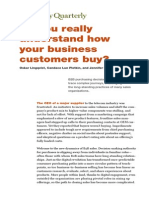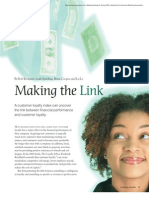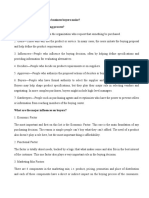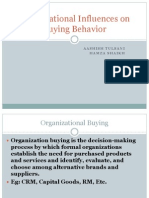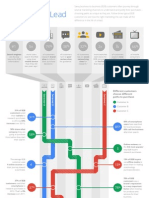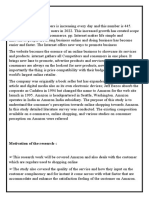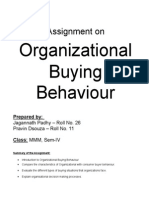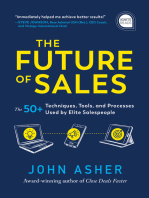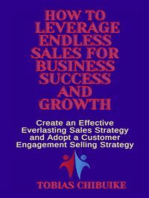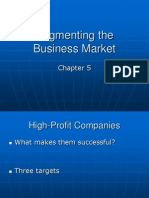Professional Documents
Culture Documents
2012-B2b Buyer Behavior Survey
Uploaded by
d_ansari26Copyright
Available Formats
Share this document
Did you find this document useful?
Is this content inappropriate?
Report this DocumentCopyright:
Available Formats
2012-B2b Buyer Behavior Survey
Uploaded by
d_ansari26Copyright:
Available Formats
T H E 2 012
B2B BUYER BEHAVIOR
S U R V E Y:
New Challenges, New Complexity
Sponsored by
RESEARCH
The 2012 B2B Buyer Landscape: New Challenges, New Complexity
Todays B2B buyers continue to investigate more research sources, involve more stakeholders and take more time to make their purchasing decisions than ever before. Its a trend with major implications for sales and marketing professionals especially when a surprisingly large number of buyers say they are dissatised with their purchasing experiences. These are some of the major ndings of the third annual Inside The Mind Of The B2B Buyer Survey, conducted by Demand Gen Report and sponsored by Act-On Software. The 2012 survey, which polled more than 170 B2B buyers involved in the purchase of a solution during the past year, revealed several noteworthy trends:
The number of respondents who said they were dissatised with their B2B buying experience jumped by 50% over 2011, suggesting a serious gap between buyer expectations and vendor performance; The number of buyers who say they now use a wider variety of sources to research purchases also increased by 50% over 2011; Buyers who say they involve more team members in the buying process jumped by 67% over the 2011 study; The number of buyers who said they spent more time researching B2B purchases increased by 15% over 2011.
The following report will explore these and other ndings from the 2012 survey. It will also explain why some trends uncovered in the study, including the growing length and complexity of the B2B sales process, support a growing need for marketing automation technology, and for the business processes and content required to support a marketing automation strategy.
The 2012 B2B Buyer Landscape: New Challenges, New Complexity
The Big Picture: A Longer, More Complex Buying Process
According to the survey, B2B buyers are adopting increasingly complex decision-making processes that require them to nd, share and evaluate more information than ever before. In fact, this trend is noticeable across the board, based on a comparison of the 2012 and 2011 survey results: 67% of buyers say they are using a wider variety of sources to research their vendor options versus 47% of the buyers surveyed in 2011; 55% say they spend more time researching purchases than they did in the past compared to 47% of the buyers surveyed in 2011; 50% allow more internal team members to provide input into the decision-making process compared to 30% of the buyers surveyed in 2011; 45% conduct more detailed cost/ROI analyses versus 34% of the buyers surveyed in 2011; Just 9% say they involve fewer team members in their B2B buying decisions compared to 17% in 2011. While half of the respondents said they involved one to three people in their most recent B2B purchase, more than 38% said they involved between four and seven people, and nearly 12% involved more than eight people in the purchase. The vast majority (76%) of respondents said C-level executives were involved in the decision, more than two-thirds (69%) involved marketing, and at least 30% of the respondents said they involved nance, IT, operations and/or sales teams in the buying process. These ndings are consistent with the trend of longer sales cycles that most B2B organizations are facing, said Andrew Gaffney, Publisher of Demand Gen Report. However, they also provide deeper insights into where pipelines may be getting clogged. Companies that use the right automated tools to track the digital behavior of their prospects have seen improved deal velocity; they are able to see changing inuences on buying behavior.
How would you say the decision-making process changed for your most recent purchase versus previous purchases in recent years?
(Please check all that apply)
How many people were involved in the purchase process?
5%
Used a wider variety of sources to research options Spent more time researching this purchase than previous purchases More internal team members provided their input into decision process Did more detailed analysis of costs/ROI of solution before making a nal decision Spent more time on social media to research possible solutions Relied more on live customer feedback/recommendations Fewer internal team members provided their input into decision process
7%
66% 48% 38% 30% 20% 19% 9%
38%
50%
1-3 4-7 8-10 11+
The 2012 B2B Buyer Landscape: New Challenges, New Complexity
B2B Buyers Give Vendors Mixed Reviews
Perhaps the most surprising nding in the 2012 study, however, was a sharp increase in the number of respondents who said they were not satised with their B2B buying experience. When asked to rate the overall experience of their most recent B2B purchase on a scale of 1 to 5 (with 1 being most positive), buyers responded with an average rating of just 3.34 and nearly 56% of all buyers surveyed rated their experience with a less-satised 4 or 5 rating. Our 2011 study, by comparison, found that 36% of the buyers surveyed were dissatised with their experience. The fact that buyers are increasingly dissatised with the engagement process is one of the most eye-opening statistics from the survey, Gaffney said. Despite all of the tools available CRM, web analytics and marketing automation this shows that marketing and sales teams are still struggling to keep pace with the changing expectations of buyers. This also underscores that those rms that can transform their engagement models rapidly will have a decided advantage over their competitors. What explains this growing dissatisfaction on the part of buyers? There are a number of contributing factors, all of which will be discussed below. In general, however, it is clear that buyers are taking longer to make decisions; at the same time, the decision-making process is increasingly complex and often involves more people. If marketers fail to adapt the tools and techniques required to give these buyers the content they need to make decisions and to communicate with them in an appropriate manner, often over an extended period then they risk failing to meet a buyers expectations.
The fact that buyers are increasingly dissatised with the engagement process is one of the most eyeopening statistics from the survey. Despite all of the tools available CRM, web analytics and marketing automation this shows that marketing and sales teams are still struggling to keep pace with the changing expectations of buyers.
- Andrew Gaffney Publisher Demand Gen Report
Please rate the overall experience of your last purchase from 1-5, with 1 being the most positive.
8%
9%
12%
48%
23%
1 2 3 4 5
The 2012 B2B Buyer Landscape: New Challenges, New Complexity
Relevant, Timely Information Plays A Critical Role
One way to gain insights about this satisfaction gap is to ask buyers which factors they consider most important when selecting a vendor. According to the 2012 survey, two responses were overwhelmingly popular: 53% said that the relevance of the information a company provided was very important; and 57% of the respondents ranked the timeliness of a vendors response to their questions/inquiries as very important. The amount of content/thought leadership a company provided was also important to buyers, as were recommendations from colleagues at companies similar to their own. The prominent role played by relevant content, timely responses and insightful thought leadership all point to the vital role that marketing organizations play in shaping a buyers impressions of a brand either directly (via content and campaign activity) or indirectly (via alignment with sales). These ndings also suggest that sales and marketing organizations need to adopt tools and techniques that identify buying signals as they occur, and that allow organizations to engage with buyers in a timely manner. All of the ndings point to a greater reliance on marketing for the early stages of engagement in the B2B buying cycle, Gaffney said. Because buyers are engaging with a sales representative later in the process, the content and messaging a brand delivers really shapes the initial perception of a brand and can have a dening impression on brand preference. 5.22
Relevance of the information the company provided based on my questions
Once you decided to research solution providers, how important were the following factors in selecting the provider you ultimately chose to work with?
(Respondents were asked to rank from 1-7 in importance. The statistics below reect the average rating.)
5.05
Timeliness of their response to questions/inquiries
4.33
The amount of content/thought leadership the company provided to support our research
3.85
The companys involvement as a thought leader in industry online communities, blogs, etc.
4.07
Recommendations/references from companies similar to mine
3.34
Ranking from industry trade publications/press
2.15
Positioning and presence at industry conferences/ trade shows
The 2012 B2B Buyer Landscape: New Challenges, New Complexity
B2B Buyers Report More Unbudgeted Purchases
Does Social Media Really Matter To B2B Buyers?
Budgeting for B2B purchases has also shifted signicantly in favor of rms completing purchases that were initially unbudgeted, but that were deemed necessary after looking at a solutions impact on other adopters and building an internal business case for the solution. In 2011, just 11% of the respondents to the B2B Buyer Survey reported making their most recent solution purchase in this manner; in 2012 that number jumped to 48%. While there may be a number of factors contributing to this budget allocation trend, such a shift has major implications for B2B marketers: First, it demonstrates yet again that B2B buyers are taking more time and involving more decision-makers in the buying process. It also suggests that buyers will require more content designed to build a business case and to demonstrate ROI for a particular product or solution a trend borne out by other ndings in this years study.
Is social media truly an essential part of the B2B buying process? Previous B2B Buyer surveys offered a mixed bag of answers to this question; while 65% of buyers in 2010 said they used social media during the purchase process, just 35% of the buyers surveyed in 2011 said they did so. This year, 72% of our respondents said they used social media to research their solution purchase. The difference, however, is that this years survey offered a number of specic social media activities for respondents to choose. As a result, while more than 53% said they followed group discussions to learn more about business solutions, just 14% said they connected directly with solution providers over social networking channels. One conclusion is that social media does play a critical role in the purchasing process, even though most buyers avoid direct contact with vendors over social media. This suggests that B2B marketers must adopt sophisticated strategies for monitoring social media conversations and tracking buyer behavior even when they dont necessarily make direct contact with buyers. When asked which social media sources they found most inuential, blogs and LinkedIn stood out, with inuence scores (on a 1-7 scale) of 5.29 and 5.28, respectively. SlideShare and YouTube/video content also did well, while Twitter, Facebook and Pinterest showed low to moderate levels of inuence.
How would you describe the budgeting/approval process for this recent solution purchase?
% 14
15%
48%
How did you use social media to research your solution purchase?
23
(Please check all that apply)
Followed group discussions/conversations/ threads to learn more about the topic The project was initially allocated after we determined the solutions potential impact by looking at other adopters and building an internal business case for it. Budget for project was pre-approved and allocated at the beginning of the year Budget was allocated as part of a larger line item once need was established and ROI was clearly demonstrated Budget was determined after soliciting multiple bids I did not use social media Connected individually with thought leaders in the space through social networks Posted questions to social media asking how others solved a similar business challenge
54% 28% 24% 22%
Connected directly with potential solution providers via social networking channels 14%
The 2012 B2B Buyer Landscape: New Challenges, New Complexity
Vendors Get Mixed Reviews On Their Contact Choices
As noted previously, B2B buyers continue to push back their initial point of contact with vendors including the vendors they nally select. In the 2011 B2B Buyer Survey, 22% of respondents said they interacted with a contact from a solution provider almost immediately, as soon as they started their initial research. In the 2012 survey, that number dropped to just 6%. At the same time, the number of respondents initiating contact with a vendor only after compiling a short list of candidates jumped from 24% to 51%. While buyers are waiting longer before initiating direct contact with vendors, this trend hasnt cut the number of contacts they have with a solution provider. In fact, more than a third of respondents (35%) reported at least four contacts (via sales calls, email or other methods) with the winning vendor, and 31% said they had eight or more contacts. These ndings really validate the critical role that multi-touch lead nurturing campaigns are playing in the buying process, Gaffney said. Buyers expect to be contacted multiple times by solution providers, but they also expect that those touches be relevant to their current information needs. If they have already engaged with a brand and attended three of their webinars, they dont expect (or appreciate) messaging that treats them like a new prospect. Relevance is really becoming table stakes, and the ability to guide and accelerate the buying process is critical.
At what point did you interact with a contact from the solution provider?
After establishing a preferred list of vendors After conducting initial research on options When we put out RFPs Immediately when research began When we were ready to negotiate terms Other
How many times did the winning vendor contact you vial sales calls, email or other methods before you made a final decision?
51%
14%
28% 8% 6% 5% 2%
17%
35%
34%
1-3 4-7 8-10 11+
The 2012 B2B Buyer Landscape: New Challenges, New Complexity
A related question is whether buyers are satised with vendors choices about how and when to contact them. This years survey reported mixed results on this question: While 59% of buyers said their vendors did a good job of maintaining appropriate contacts, 33% said vendors did only a fair job at this task, and another 8% said vendors did a poor job. The fact that 4 out of 10 buyers rated their vendors as fair or poor on this count could be another contributing factor to the relatively low vendor-satisfaction ratings the survey uncovered. It also suggests that vendors need to invest in solutions that give them greater control over how, when and why they contact potential buyers.
These stats speak to the challenges most B2B marketers face when creating lead nurturing campaigns. Knowing when to communicate and what to say is crucial to building trust with your buyers, said Atri Chatterjee, CMO at Act-On Software. Todays marketing automation platforms are so sophisticated that marketers can run highly targeted nurturing campaigns based on a buyers online behavior. One point where buyers appear not to have a problem is with the quantity of content vendors provide: More than 87% said they are satised that vendors provide ample content to guide them through the decision-making process.
How would you describe the vendors choices about how and when to contact you?
8%
33% 59%
Did you feel like the solution provider you chose provided ample content to help you through each stage of your research and decision-making?
87%
Yes No
13%
Good: their contacts were appropriate and helpful Fair: they could have adjusted their contact frequency to reect my needs more efciently Poor: I was contacted more times than necessary
The 2012 B2B Buyer Landscape: New Challenges, New Complexity
Buyers Favor Industry-Specific Content
Not surprisingly, buyers begin their vendor search process with a wide range of research tactics, including web searches, visits to vendor web sites, downloaded white papers, and social media or peer reviews. A majority of buyers use these tools as part of an informal research process where they gather information related to a specic business challenge. Many buyers place a special emphasis on industry-specific articles and research during their initial search process, while a smaller but still signicant number seek out case studies involving companies similar to their own.
At the start of your search process, what marketing/media channels influenced your selection of solution providers in this purchase? (Please check all that apply)
Web search Vendor web site Downloaded white paper Social media/peer reviews Responding to direct contact from a sales rep Attended an industry event Responded to an email offer
How did you initiate your information gathering process?
8%
78% 78% 55% 50% 30% 21% 19%
27%
Started with informal research/information gathering around a business challenge Conducted anonymous research of a select group of vendors via their web sites and other public information Engaged with peers who had addressed a similar challenge and learned more about the solutions/processes they used
What particular types of information did you seek out in your initial search?
Followed industry conversations/coverage of the topic and used that knowledge to engage with one or more potential solution providers
% 12
54%
13%
15%
Articles and resources targeted to my industry
45%
27 %
Case study examples of other companies similar to mine Made relevant professional connection with others who operate in m industry and/or could help with my search process (e.g. connecting on LinkedIn) Research briefs
The 2012 B2B Buyer Landscape: New Challenges, New Complexity
Virtually all B2B buyers (94%) view multiple pieces of content from the vendor they ultimately select. While this is not surprising, it reinforces the need for vendors to develop coherent content marketing strategies. The next step in the buying process, according to nearly half (43%) of respondents, is to develop a short list of potential vendors to discuss internally, while 36% say their next step is to build a business case for the vendors product or service (and, presumably, to carve out budget for the purchase).
Both of these likely next steps indicate that B2B buyers now go through an extended, and largely internal, decision-making process before they need or want closer engagement with vendors. They also illustrate the role that a sophisticated lead nurturing program can play in ensuring that B2B buyers get appropriate content as exactly the right point in the vendor evaluation process.
Did you view multiple pieces of content from the vendor you ultimately selected?
After you began your initial search, what was your next step?
6%
15 %
94%
43%
Yes No
6%
10
The 2012 B2B Buyer Landscape: New Challenges, New Complexity
36
Developed a short list of potential solutions or services to discuss internally Collected initial information and resources to build the business case/need Looped in relevant internal stakeholders Initiated budgeting discussions internally
Web Site Content: Relevance, Diversity Are Important
Buyers were also asked to comment specically on their impressions of their chosen vendors web sites still the rst (and often only) stop for content and research tools. According to the survey: Buyers were most likely to cite both the breadth of relevant product information and the educational value of that information as the most compelling elements of their chosen vendors web site; More than half (51%) said they did not have to log in to access a vendors content, and 29% said they were required to provide information only once, even if accessing multiple pieces of content; and A large majority (73%) said they arent interested in using social sign-in tools to access content. The second and third points here both illustrate a single conclusion: Buyers are inherently (and perhaps increasingly) hostile to any form of gating on a vendor web site, whether or not it involves social sign-in or other usability improvements. This suggests that vendors must be especially careful in terms of when to gate content and what information to request when content is gated.
What did you find to be the most compelling element of your chosen vendors web site?
How did you access content provided by the vendor?
I did not have to log in to access the vendors content
51% 29% 15% 5%
8%
14 %
I logged in once (name, email, company) and was not required to thereafter
30%
I was required to login each time I was able to use social sign-in to access content
19%
Breadth of product information as it related to my search Valuable educational content (e.g. industry-relevant white papers) Relevance of individual content (e.g. presented by role or vertical) Design aesthetic (easy to navigate and access information) Interactive info (i.e. customer success videos)
29%
11
The 2012 B2B Buyer Landscape: New Challenges, New Complexity
Understanding B2B buyers behavior and their information consumption is crucial to nurturing a successful partnership, said Chatterjee. Making sure content is easily accessible, relevant and delivered with the least number of gating features will benet your business in the long run. Todays online marketing tools employ sophisticated techniques to streamline the lead form submission process by pre-populating data capture elds and requiring the visitor to ll out a form only once to download multiple assets. These minor adjustments to your lead generation program can have a big positive impact on your results.
Selected B2B Buyer Comments
As part of this year's survey, Demand Gen Report asked respondents to provide optional comments on their vendor experiences. Several of these comments expressed oftenrepeated sentiments that offer some insights into why buyers are dissatised with the vendors they work with. Several buyers expressed dissatisfaction with the late-stage buying process. "The original quote was ridiculous," noted one respondent. "The nal price was less than half of the original pricethe process felt a little sleazy." Others reected dissatisfaction with the type of content available from vendors: "Availability of a free trial or test environment would have been very helpful," stated one buyer, while another noted "If I am buying a product all the thought leadership in the world is irrelevant if I cannot get to product-level information. If I cannot get this information, you are often off my list very fast and may never come on again." Another commenter echoed the previous sentiment: "More product detail on websites is essential for a B2B buyer."
Would you prefer the option to use social sign-in to access content?
73%
Yes No
27%
Finally one commenter summed up a number of other complaints about sales calls that were either inappropriate or simply too aggressive. Stop all the phone calls and worthless emails from the sales reps, the commenter said. If and when Im really interestedIll reach out to you. Dont HOUND me or my team.
12
The 2012 B2B Buyer Landscape: New Challenges, New Complexity
Demos, Comparison Content Drive Late-Stage Decisions
This years study also looked at the specic impact of late-stage content on B2B buyer decisions. In this area, a few key conclusions stood out: More than 72% of buyers cited tools designed to support the business case for a purchase as having a signicant impact; Nearly 63% said case studies played a role in moving them towards a nal choice, although signicant numbers also cited checklists/guides (47%), analyst reports (45%) and ROI calculators (34%). Online demos (cited by 69%) and free trials (42%) were the most commonly cited pieces of content used to make a nal vendor decision.
B2B buyers clearly want to test drive solutions before they commit to integrating them into their business. Those organizations that help prospects get comfortable seeing how a solution works in their own environment have a much better chance of winning a longterm customer.
- Andrew Gaffney Publisher Demand Gen Report
How did the solution provider help you through your decisionmaking process?
(Please check all that apply)
After you moved past the initial search phase, what information did you seek out as you started to consider specific solution providers?
(Please check all that apply)
Provided tools to support the business case for my purchase Brought in high-level executives to share thought leadership expertise Invited me/my team to an industry event or analyst webinar Other
72% 34% 34% 17%
Case study examples
63% 47% 45% 34%
Action-oriented checklists or guides
Analyst reports
ROI calculators
13
The 2012 B2B Buyer Landscape: New Challenges, New Complexity
B2B buyers clearly want to test drive solutions before they commit to integrating them into their business, said Gaffney. This is especially true in enterprise software, but is also becoming the case with services businesses as well. Those organizations that help prospects get comfortable seeing how a solution works in their own environment have a much better chance of winning a long-term customer.
Finally, when asked what was generally missing from solution provider web sites, a plurality of buyers (37%) cited issues with the relevance of the content they viewed, in terms of criteria like job role or industry vertical. Smaller but still signicant numbers cited a lack of breadth in content and a lack of high-quality educational content as problems.
Which types of content were most helpful in finalizing your vendor decision?
(Please check all that apply)
Looking back on your entire purchase experience, what would you say was generally missing from the solution providers whose web sites you visited?
Relevance of individualized content (i.e. presented by role or vertical) Valuable educational content (e.g. industry relevant white papers) Breadth of product information as it related to my search Interactive info (e.g. customer success videos) Design aesthetic (easy to navigate and access information)
Online demos
69% 42% 40% 26% 15% 9%
37% 20% 19% 14% 11%
Free products/free trials Assessment tools ROI calculators Video testimonials N/A
14
The 2012 B2B Buyer Landscape: New Challenges, New Complexity
Conclusion: The Road Ahead For B2B Marketers
Based on current research, it is possible that todays shifting B2B marketing landscape may soon settle into a more stable environment. Most buyers now engage with vendors late in the selection process and involve multiple stakeholders in decisions; most also require multiple touches, and exposure to multiple content assets, in order to select a nal vendor. The challenges, then, involve what vendors can do to improve buyer satisfaction, deliver quality content to the right decision-makers at the right time, and maintain contact without coming across as overbearing. These challenges are particularly important, given that a growing number of buyers say they are not satised with their experiences. Many B2B marketers now agree that marketing automation when combined with quality content and good sales/marketing alignment provides an effective solution to these issues. Marketing automation enables complex, long-term lead nurturing campaigns; it also allows marketers to segment their prospects and deliver targeted, highly relevant content. In the process, marketing automation could help B2B marketers overcome the dissatisfaction many buyers report during their dealings with vendors.
About The Survey
The 2012 Inside The Mind Of the B2B Buyer Survey includes responses from more than 170 respondents actively involved in purchasing a business solution within the last 12 months. Of these respondents 29% described their role in the process as a recommender, developing project guidelines and selection criteria. Another 36% described themselves as inuencers, helping to develop the business need for a solution; 25% described themselves as the nal decisionmakers for a purchase; and 10% said their main role was to approve or allocate the budget for a purchase. Most of the respondents (63%) reported annual company revenue of less than $25 million, while 26% reported revenue of $25-$250 million. Approximately 5% reported revenue of $250-$500 million, and 7% reported revenue of greater than $500 million.
What role did you play in the purchase of a B2B solution (i.e. software, professional services, technology) in the last 12 months?
Please describe your companys annual revenue:
Under $25 milllion
63% 26% 6% 5% 1%
9%
15 %
30%
$25 million to $250 million
More than $1 Billion
21%
Inuencer (helped develop the need) Recommender (developed project guidelines/vender selection criteria) Decision maker (made nal decision) Was not directly involved in the purchase of a B2B solution during the past 12 months Buyer (approved/allocated budget)
15
% 25
$250 million to $500 million
$500 million to $1 billion
The 2012 B2B Buyer Landscape: New Challenges, New Complexity
About
About Act-On Software
Act-On Software provides marketing automation for the Fortune 5,000,000. We give small and mid-sized businesses the ability to do sophisticated, multi-channel marketing, via a simple yet powerful package of integrated capabilities. Our customers increase their revenue, reduce their cost of customer acquisition, and interact with their prospects and customers using online capabilities including email, the web and social media. Until now, these capacities were available only to large enterprises spending hundreds of thousands of dollars in software and resources; Act-On has changed all that by levelling the playing eld. With a relentless focus on customer success and continuous innovation, Act-On today is the fastest-growing marketing automation company in the industry. Headquarters 8405 SW Nimbus Ave, Suite E Beaverton, Oregon 97005 +1 (877) 530 1555 International: +91 80 4098-5338 www.act-on.com
About Demand Gen Report
Demand Gen Report is a targeted e-media publication spotlighting the strategies and solutions that help companies better align their sales and marketing organizations, and ultimately, drive growth. A key component of the publications editorial coverage focuses on the sales and marketing automation tools that enable companies to better measure and manage their multi-channel demand generation efforts. DemandGen Report 411 State Rt. 17 South, Suite 410 Hasbrouck Heights, NJ 07604 P: 201.257.8528 F: 201.257.5281 info@demandgenreport.com
16
The 2012 B2B Buyer Landscape: New Challenges, New Complexity
You might also like
- Kawasaki JetSki Watercraft ULTRA LX (JT1500-C7.8.9F) '07 A '09 - Service ManualDocument479 pagesKawasaki JetSki Watercraft ULTRA LX (JT1500-C7.8.9F) '07 A '09 - Service ManualGrzegorz Miąsko100% (2)
- Guide To Engine Oil Claims and Specs Top TechDocument1 pageGuide To Engine Oil Claims and Specs Top Techd_ansari26No ratings yet
- BtoB Open QuestionsDocument4 pagesBtoB Open QuestionsAkrati PatelNo ratings yet
- CEM Reading Customer EmotionsDocument3 pagesCEM Reading Customer EmotionsSakshi ShahNo ratings yet
- Impact of Online Reviews On Consumer Buying BehaviorDocument12 pagesImpact of Online Reviews On Consumer Buying BehaviorVaibhav KatariaNo ratings yet
- SKF Marketing Case StudyDocument2 pagesSKF Marketing Case Studyd_ansari260% (2)
- How To Conduct Lubrication AuditDocument23 pagesHow To Conduct Lubrication Auditd_ansari26100% (4)
- How To Be A Great Project ManagerDocument24 pagesHow To Be A Great Project ManagerProjectManagercom100% (16)
- Whitepaper Definitive Guide Social SellingDocument12 pagesWhitepaper Definitive Guide Social SellingAnduftwNo ratings yet
- Winning at Sales in A Buyer-Empowered WorldDocument5 pagesWinning at Sales in A Buyer-Empowered WorldDeta DetadeNo ratings yet
- Do You Really Understand How Your Business Customers BuyDocument11 pagesDo You Really Understand How Your Business Customers Buyabhishekkr26jNo ratings yet
- AST-0060828 Improving Sales Effectiveness in A Buyers MarketDocument12 pagesAST-0060828 Improving Sales Effectiveness in A Buyers MarketLuis Jesus Malaver GonzalezNo ratings yet
- FordDocument45 pagesFordkavyansh mainiNo ratings yet
- Research Paper On Retail Marketing PDFDocument7 pagesResearch Paper On Retail Marketing PDFafnhinzugpbcgw100% (1)
- Measuring customer loyalty index links to company financial performanceDocument5 pagesMeasuring customer loyalty index links to company financial performanceGuidoNo ratings yet
- Final Proposal File 2Document11 pagesFinal Proposal File 2Muhtasim SianNo ratings yet
- Business Buyers' Decision-Making Process and FactorsDocument9 pagesBusiness Buyers' Decision-Making Process and FactorsNaol danielNo ratings yet
- Thesis About Purchase DecisionDocument6 pagesThesis About Purchase Decisionfjgtq12d100% (2)
- Buyer BehaviorDocument8 pagesBuyer BehaviorMuhammad SaudNo ratings yet
- MKT 414 Final Previous SemesterDocument41 pagesMKT 414 Final Previous SemesterMd. Shahriar Haque ShishirNo ratings yet
- Assignment 1- Read a research paper- Reading 4- Nguyễn Thị Thơm - 11203788Document2 pagesAssignment 1- Read a research paper- Reading 4- Nguyễn Thị Thơm - 11203788nguyenthithomk2neuNo ratings yet
- Customer Satisfaction with Tata MotorsDocument42 pagesCustomer Satisfaction with Tata MotorsNaveen KNo ratings yet
- Customer Satisfaction of Online Shopping in BangladeshDocument13 pagesCustomer Satisfaction of Online Shopping in BangladeshMd. Shahriar Haque ShishirNo ratings yet
- The Importance of Territory Design PDFDocument10 pagesThe Importance of Territory Design PDFCaleb ChaseNo ratings yet
- Purchase Decision ThesisDocument4 pagesPurchase Decision Thesisafcmayfzq100% (2)
- Free Research Paper On Internet MarketingDocument6 pagesFree Research Paper On Internet Marketingaferauplg100% (1)
- CGT Research May 2013: Analytics & InsightsDocument2 pagesCGT Research May 2013: Analytics & InsightsCognizantNo ratings yet
- Organizational Influences On Buying Behavior: Aashish Tulsani Hamza ShaikhDocument26 pagesOrganizational Influences On Buying Behavior: Aashish Tulsani Hamza ShaikhThomas PhillipsNo ratings yet
- Research AliDocument14 pagesResearch AliAli AhmadNo ratings yet
- Outline Three Characteristics of Business Markets in Comparison To Consumer MarketsDocument8 pagesOutline Three Characteristics of Business Markets in Comparison To Consumer MarketsChunhui LoNo ratings yet
- The State of Marketing 2011Document29 pagesThe State of Marketing 2011Mark SiebertNo ratings yet
- Rethink b2b Buyers Journey v03.09 Eng UsDocument32 pagesRethink b2b Buyers Journey v03.09 Eng UsBa Láp Ba LúaNo ratings yet
- B2B Ultimate Sales FunnelDocument10 pagesB2B Ultimate Sales FunnelRavtej Sandhu100% (2)
- Impact of E-Marketing on Consumer BehaviorDocument6 pagesImpact of E-Marketing on Consumer BehaviorVikash KumarNo ratings yet
- Promotional Strategy Group ProjectDocument22 pagesPromotional Strategy Group ProjectSwati AryaNo ratings yet
- Changing Attitude of Indian Consumer Towards Online ShoppingDocument36 pagesChanging Attitude of Indian Consumer Towards Online ShoppingSai KiraNo ratings yet
- Research Design of Negative Online Reviews Have An Impact On Consumer Purchase IntentionDocument7 pagesResearch Design of Negative Online Reviews Have An Impact On Consumer Purchase IntentionTasnim AhmedNo ratings yet
- Social Media 2014 FINALDocument9 pagesSocial Media 2014 FINALLeslie ShowalterNo ratings yet
- Research Paper On Conversion of FootfallDocument11 pagesResearch Paper On Conversion of FootfallAbu BasharNo ratings yet
- Coustmer Behaviour Towards FlipkartDocument77 pagesCoustmer Behaviour Towards FlipkartPINTU TOMAR80% (5)
- Chap2 12berryDocument11 pagesChap2 12berryAlexia NoolNo ratings yet
- AribowoDocument11 pagesAribowoeca 1104No ratings yet
- Factors Affect Motivation of Buyer FinalDocument23 pagesFactors Affect Motivation of Buyer FinalChristine Cubar PallarNo ratings yet
- Post-Purchase Activities and Their Impact On Customers SatisfactionDocument16 pagesPost-Purchase Activities and Their Impact On Customers SatisfactionMd. Shahriar Haque ShishirNo ratings yet
- Customer-Driven Marketing Strategies and OrientationsDocument5 pagesCustomer-Driven Marketing Strategies and Orientationsmb baNo ratings yet
- Buygrid Framework Buygrid Framework: DescriptionDocument2 pagesBuygrid Framework Buygrid Framework: DescriptionSreekant100% (1)
- Mahad Rizwan (89), Fakhar Abbas (92), Farooq Azam (90) : TeamDocument7 pagesMahad Rizwan (89), Fakhar Abbas (92), Farooq Azam (90) : TeamMahad RizwanNo ratings yet
- Qualitative Marketing Research: Its Shop Sans Stops NowDocument5 pagesQualitative Marketing Research: Its Shop Sans Stops Nowbinzidd007No ratings yet
- Life of A LeadDocument1 pageLife of A LeadrussmmeyerNo ratings yet
- A Study On Consumers Buying Behaviour Based On Customers OnlineDocument8 pagesA Study On Consumers Buying Behaviour Based On Customers Onlinefaisal qariabNo ratings yet
- BRM Project Group 4Document8 pagesBRM Project Group 4thakurjayshree50No ratings yet
- How Social Media and Digital Marketing Tactics Impact Customer Purchasing BehaviorDocument7 pagesHow Social Media and Digital Marketing Tactics Impact Customer Purchasing Behaviorash broNo ratings yet
- Week 4 Learning Material: Key ConceptsDocument9 pagesWeek 4 Learning Material: Key Conceptshajra ubaidNo ratings yet
- Final Project Report On Customer Satisfaction On BSNL Landline and Mobile ServicesDocument91 pagesFinal Project Report On Customer Satisfaction On BSNL Landline and Mobile ServicesTadi Dileep80% (35)
- Brand Advocacy and Brand Bonding: New Parameters in Consumer Purchase Decision Journey in The Digital WorldDocument18 pagesBrand Advocacy and Brand Bonding: New Parameters in Consumer Purchase Decision Journey in The Digital WorldMuhammad IfthikharNo ratings yet
- Customer SatisfactionDocument20 pagesCustomer SatisfactionKatlene JoyNo ratings yet
- Marketing Research Mino Project ReportDocument6 pagesMarketing Research Mino Project Reportshailendra singhNo ratings yet
- JHI Volume05 Issue02 Pages56-60Document6 pagesJHI Volume05 Issue02 Pages56-60AisuNo ratings yet
- Organizational Buying Behaviour: Assignment OnDocument6 pagesOrganizational Buying Behaviour: Assignment OnPrafful Ratna AggrawalNo ratings yet
- A Study On Parameters of Online ReviewsDocument13 pagesA Study On Parameters of Online ReviewsrajisumaNo ratings yet
- AbstractDocument7 pagesAbstractMeena SivasubramanianNo ratings yet
- Customer Switching Behavior in Banking SectorDocument80 pagesCustomer Switching Behavior in Banking SectorMuhammad ImranNo ratings yet
- Research Paper On Retail MarketingDocument8 pagesResearch Paper On Retail Marketingovkpwsgkf100% (1)
- The Future of Sales: The 50+ Techniques, Tools, and Processes Used by Elite SalespeopleFrom EverandThe Future of Sales: The 50+ Techniques, Tools, and Processes Used by Elite SalespeopleNo ratings yet
- How to Leverage Endless Sales for Business Success and Growth: Create an Effective Everlasting Sales Strategy and Adopt a Customer Engagement Selling StrategyFrom EverandHow to Leverage Endless Sales for Business Success and Growth: Create an Effective Everlasting Sales Strategy and Adopt a Customer Engagement Selling StrategyNo ratings yet
- Water Contamination LevelsDocument2 pagesWater Contamination Levelsd_ansari26No ratings yet
- AtfDocument42 pagesAtfClaudio Cerda MNo ratings yet
- B2B Social Marketing SurveyDocument10 pagesB2B Social Marketing Surveyd_ansari26No ratings yet
- Segmentation Case Study PharmaDocument1 pageSegmentation Case Study Pharmad_ansari26No ratings yet
- Segmenting The Business MarketDocument12 pagesSegmenting The Business Marketd_ansari26No ratings yet
- Machinery Lubrication MagazineDocument82 pagesMachinery Lubrication Magazined_ansari26No ratings yet
- Driving Safety WorkshopDocument35 pagesDriving Safety Workshopd_ansari26No ratings yet
- Addisons Disease Control GuidelinesDocument24 pagesAddisons Disease Control Guidelinesd_ansari26No ratings yet
- Warehousing Safety Principles PDFDocument4 pagesWarehousing Safety Principles PDFd_ansari26No ratings yet
- Lubrication of Rolling Bearings Tips and AdviceDocument44 pagesLubrication of Rolling Bearings Tips and Adviced_ansari26100% (1)
- R&AC Lecture 19Document24 pagesR&AC Lecture 19api-3734466No ratings yet
- Warehousing Safety Principles PDFDocument4 pagesWarehousing Safety Principles PDFd_ansari26No ratings yet
- 2011 B2B Marketing Mix Survey ResultsDocument14 pages2011 B2B Marketing Mix Survey ResultsSagefrogNo ratings yet
- Lubrication SelectionDocument11 pagesLubrication Selectionjr110livecomNo ratings yet
- Bulletin Dec 08Document22 pagesBulletin Dec 08d_ansari26No ratings yet
- Soundbridge IVDocument4 pagesSoundbridge IVapi-213601066No ratings yet
- Air Enters The Compressor of A Gas Turbine at 1...Document4 pagesAir Enters The Compressor of A Gas Turbine at 1...Juan DiegoNo ratings yet
- Pail 5142811 40Document3 pagesPail 5142811 40Ryan ColeNo ratings yet
- Study of Dies and InsertsDocument14 pagesStudy of Dies and InsertstraidenNo ratings yet
- (1-01) Spesifikasi BTL-6000 High Intensity Laser 12 Watt (HIL 12 Watt)Document2 pages(1-01) Spesifikasi BTL-6000 High Intensity Laser 12 Watt (HIL 12 Watt)Fardiyan SyafriNo ratings yet
- Metode Ugradnje Tunelske FolijeDocument7 pagesMetode Ugradnje Tunelske FolijeIzetNo ratings yet
- Base OilsDocument2 pagesBase Oilsingbarragan87No ratings yet
- Understanding Community DevelopmentDocument20 pagesUnderstanding Community DevelopmentKorean Jagiya100% (1)
- RC Roof Beam DesignDocument5 pagesRC Roof Beam DesignSujay SantraNo ratings yet
- Abs Dodge Charger 2008Document2 pagesAbs Dodge Charger 2008AUTOMOTRIZ TIPO SPCANo ratings yet
- Trainning and DevelopmentDocument33 pagesTrainning and DevelopmentDeepika BrejaNo ratings yet
- The Growing Challenge of Global Leadership DevelopmentDocument20 pagesThe Growing Challenge of Global Leadership DevelopmentSwapnil JaiswalNo ratings yet
- A Paper Presentation On SteganographyDocument13 pagesA Paper Presentation On SteganographyGovind Reddy100% (1)
- 601-620 Instruction ManualDocument120 pages601-620 Instruction ManualChinmayMaxNo ratings yet
- A1.4 Project Execution PlanDocument9 pagesA1.4 Project Execution PlanTAHER AMMAR100% (2)
- Project With Header Spring 2015 PDFDocument111 pagesProject With Header Spring 2015 PDFPavan Sandeep V VNo ratings yet
- Dairy Farm Group Case StudyDocument5 pagesDairy Farm Group Case Studybinzidd007No ratings yet
- SATR-J-6512 - Rev 0 PDFDocument5 pagesSATR-J-6512 - Rev 0 PDFAdel KlkNo ratings yet
- QA MATRIX SHEET - RadiatorDocument4 pagesQA MATRIX SHEET - RadiatorBaljeet SinghNo ratings yet
- Measurement Sheet: S.N. Description NO. L. B. D/H. Qtty. 1 TotalDocument19 pagesMeasurement Sheet: S.N. Description NO. L. B. D/H. Qtty. 1 Totaldan12345_007No ratings yet
- Module 4 Typesetting FactorsDocument57 pagesModule 4 Typesetting FactorsMirajane StraussNo ratings yet
- 1-WAY SOLID CONCRETE SLAB DESIGN To BS 81101997 Table 3.12Document7 pages1-WAY SOLID CONCRETE SLAB DESIGN To BS 81101997 Table 3.12Miguel Angel GalindoNo ratings yet
- 48v 100A Relay SealedDocument1 page48v 100A Relay SealedLIN TIMOFEINo ratings yet
- 25509-100-V1B-EKL0-00966 - Substation Building Structural Design BasisDocument15 pages25509-100-V1B-EKL0-00966 - Substation Building Structural Design BasisAnonymous FHkX0ANo ratings yet
- SVSCE/EEE/EE8511 Control and Instrumentation LaboratoryDocument105 pagesSVSCE/EEE/EE8511 Control and Instrumentation Laboratorysaikarthick023100% (2)
- RSView 32Document5 pagesRSView 32Josephus Ravanera100% (1)
- MTE 2020 Special Edition COVID-19 AwardsDocument5 pagesMTE 2020 Special Edition COVID-19 Awardschek86351No ratings yet










